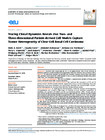Tracing Clonal Dynamics Reveals that Two- and Three-dimensional Patient-derived Cell Models Capture Tumor Heterogeneity of Clear Cell Renal Cell Carcinoma
dc.contributor.author
Bolck, Hella A.
dc.contributor.author
Corrò, Claudia
dc.contributor.author
Kahraman, Abdullah
dc.contributor.author
von Teichman, Adriana
dc.contributor.author
Toussaint, Nora C.
dc.contributor.author
Kuipers, Jack
dc.contributor.author
Chiovaro, Francesca
dc.contributor.author
Koelzer, Viktor H.
dc.contributor.author
Pauli, Chantal
dc.contributor.author
Moritz, Wolfgang
dc.contributor.author
Bode, Peter K.
dc.contributor.author
Rechsteiner, Markus
dc.contributor.author
Beerenwinkel, Niko
dc.contributor.author
Schraml, Peter
dc.contributor.author
Moch, Holger
dc.date.accessioned
2021-03-05T09:06:56Z
dc.date.available
2020-01-21T15:47:45Z
dc.date.available
2020-01-22T08:45:53Z
dc.date.available
2021-03-05T09:06:56Z
dc.date.issued
2021-01
dc.identifier.issn
2405-4569
dc.identifier.other
10.1016/j.euf.2019.06.009
en_US
dc.identifier.uri
http://hdl.handle.net/20.500.11850/392765
dc.identifier.doi
10.3929/ethz-b-000392765
dc.description.abstract
Background
Extensive DNA sequencing has led to an unprecedented view of the diversity of individual genomes and their evolution among patients with clear cell renal cell carcinoma (ccRCC).
Objective
To understand subclonal architecture and dynamics of patient-derived two-dimensional (2D) and three-dimensional (3D) ccRCC models in vitro, in order to determine whether they mirror ccRCC inter- and intratumor heterogeneity.
Design, setting, and participants
We have established a comprehensive platform of living renal cancer cell models from ccRCC surgical specimens.
Outcome measurements and statistical analysis
We confirmed the concordance of 2D and 3D patient-derived cell (PDC) models with the original tumor tissue in terms of histology, biomarker expression, cancer driver mutations, and copy number alterations. We addressed inter- and intrapatient heterogeneity by analyzing clonal dynamics during serial passaging.
Results and limitations
In-depth genetic characterization verified the presence of heterogeneous cell populations, and revealed a high degree of similarity between subclonal compositions of monolayer and organoid cell cultures and the corresponding parental ccRCCs. Clonal dynamics were evident during serial passaging of cells in vitro, suggesting that PDC cultures can offer insights into evolutionary potential and treatment susceptibility of ccRCC subclones in vivo. Proof-of-concept drug profiling using selected ccRCC-targeted therapy agents highlighted patient-specific vulnerabilities in PDC models that could not be anticipated by interrogating commercially available cell lines.
Conclusions
We demonstrate that PDC models mirror inter- and intratumor heterogeneity of ccRCC in vitro. Based on our findings, we envision that the use of these models will advance our understanding of the trajectories that cause genetic diversity and their consequences for treatment on an individual level.
Patient summary
In this study, we developed two- and three-dimensional patient-derived models from clear cell renal cell carcinoma (ccRCC) as “mini-tumors in a dish.” We show that these cell models retain important features of the human ccRCCs such as the profound tumor heterogeneity, thus highlighting their importance for cancer research and precision medicine.
en_US
dc.format
application/pdf
en_US
dc.language.iso
en
en_US
dc.publisher
Elsevier
en_US
dc.rights.uri
http://creativecommons.org/licenses/by-nc-nd/4.0/
dc.subject
Renal cancer
en_US
dc.subject
Patient-derived models
en_US
dc.subject
Tumor heterogeneity
en_US
dc.subject
Clonal dynamics
en_US
dc.subject
Personalized medicine
en_US
dc.title
Tracing Clonal Dynamics Reveals that Two- and Three-dimensional Patient-derived Cell Models Capture Tumor Heterogeneity of Clear Cell Renal Cell Carcinoma
en_US
dc.type
Journal Article
dc.rights.license
Creative Commons Attribution-NonCommercial-NoDerivatives 4.0 International
dc.date.published
2019-06-29
ethz.journal.title
European Urology Focus
ethz.journal.volume
7
en_US
ethz.journal.issue
1
en_US
ethz.journal.abbreviated
Eur Urol Focus
ethz.pages.start
152
en_US
ethz.pages.end
162
en_US
ethz.version.deposit
publishedVersion
en_US
ethz.identifier.wos
ethz.identifier.scopus
ethz.publication.place
Amsterdam
en_US
ethz.publication.status
published
en_US
ethz.leitzahl
ETH Zürich::00002 - ETH Zürich::00012 - Lehre und Forschung::00007 - Departemente::02060 - Dep. Biosysteme / Dep. of Biosystems Science and Eng.::03790 - Beerenwinkel, Niko / Beerenwinkel, Niko
en_US
ethz.leitzahl.certified
ETH Zürich::00002 - ETH Zürich::00012 - Lehre und Forschung::00007 - Departemente::02060 - Dep. Biosysteme / Dep. of Biosystems Science and Eng.::03790 - Beerenwinkel, Niko / Beerenwinkel, Niko
en_US
ethz.date.deposited
2020-01-21T15:47:53Z
ethz.source
FORM
ethz.eth
yes
en_US
ethz.availability
Open access
en_US
ethz.rosetta.installDate
2021-03-05T09:07:09Z
ethz.rosetta.lastUpdated
2022-03-29T05:38:10Z
ethz.rosetta.versionExported
true
ethz.COinS
ctx_ver=Z39.88-2004&rft_val_fmt=info:ofi/fmt:kev:mtx:journal&rft.atitle=Tracing%20Clonal%20Dynamics%20Reveals%20that%20Two-%20and%20Three-dimensional%20Patient-derived%20Cell%20Models%20Capture%20Tumor%20Heterogeneity%20of%20Clear%20Cell%20R&rft.jtitle=European%20Urology%20Focus&rft.date=2021-01&rft.volume=7&rft.issue=1&rft.spage=152&rft.epage=162&rft.issn=2405-4569&rft.au=Bolck,%20Hella%20A.&Corr%C3%B2,%20Claudia&Kahraman,%20Abdullah&von%20Teichman,%20Adriana&Toussaint,%20Nora%20C.&rft.genre=article&rft_id=info:doi/10.1016/j.euf.2019.06.009&
Dateien zu diesem Eintrag
Publikationstyp
-
Journal Article [128921]

